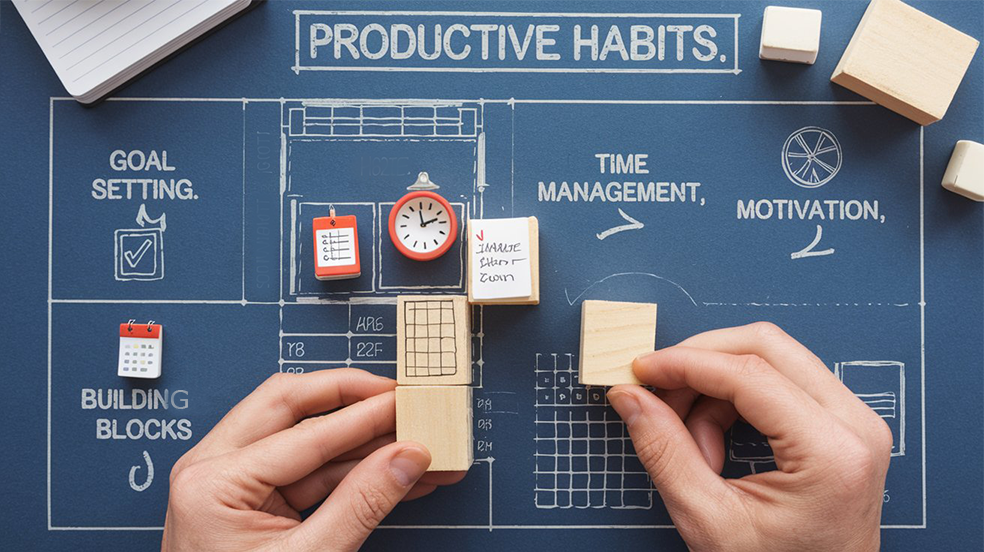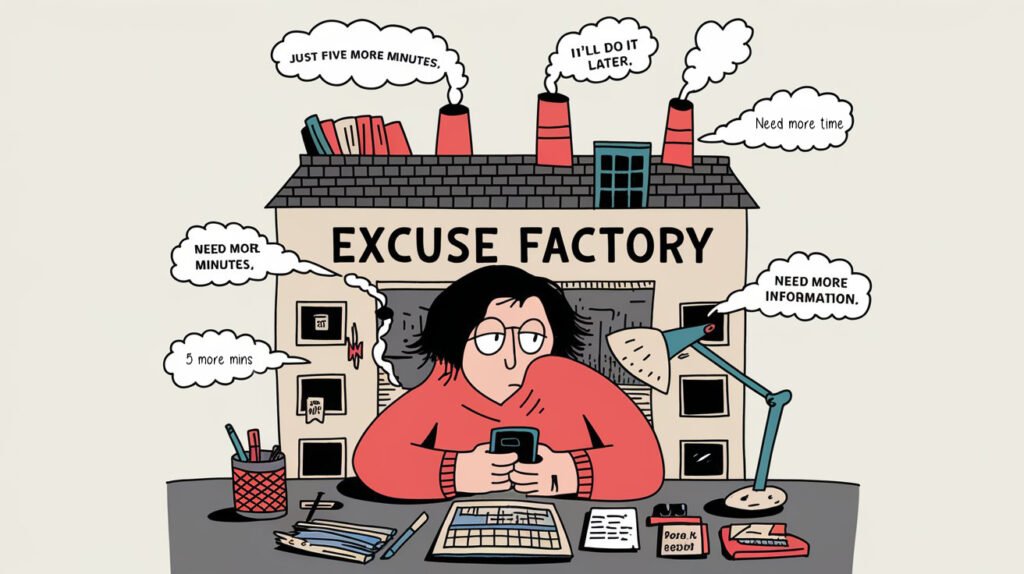Procrastination. We’ve all been there, putting off what we need to do and hoping it’ll magically do itself while we catch up on yet another random video or scroll through an endless feed. But, spoiler alert: it never does itself. Somehow, the same old excuse factory fires up every time, convincing us to wait “just five more minutes.” Sound familiar?
This blog is about getting real with how procrastination works and, most importantly, how you can kick it to the curb by building habits that actually help you get stuff done. It’s time to break free from the chains of “I’ll do it later.” Let’s talk about the mental traps, the sneaky excuses, and the science of habit-building—all in a way that makes sense and might even give you a chuckle or two. Ready to finally get on top of things?
Why We Procrastinate: The Real Deal
Procrastination isn’t just laziness on steroids. There’s a whole psychological minefield behind it. Here are the top reasons we keep hitting “pause” on our lives:
Fear of Failure
We avoid things because we’re scared of failing at them. Seriously, the only thing worse than not doing something is doing it badly, right? Fear of failure convinces us that it’s safer to delay than to dive in and possibly mess up.
Perfectionism
The perfectionist mindset says, “If I can’t do it perfectly, why bother?” It’s about holding ourselves to ridiculously high standards that are nearly impossible to meet, which often leads to doing nothing at all.
Overwhelm
When you look at a big task, your brain goes, “Yeah… not today.” Feeling like a task is too big or too complex can make starting seem impossible. Welcome to Overwhelm City. This mindset convinces us that the mountain is too high, so why even try climbing it?
Lack of Motivation
Without a reward or a clear goal, why would anyone get moving? Motivation is hard to come by if you don’t see any point in what you’re supposed to be doing. When the task isn’t interesting, motivating yourself feels like trying to hype yourself up for a dental cleaning. Without clear goals or rewards, enthusiasm tanks, and we’re back to square one.
Procrastination’s Little Helpers: Thought Patterns that Fuel the Fire
It’s not just about avoiding tasks. Procrastination loves a good excuse, and here are some crowd favorites:
- “It’s not that important right now.” Yep, this is how we justify scrolling for hours instead of tackling that task. It’s the classic move of minimizing importance.
- “I need to do X, Y, and Z first.” Distractions disguised as “priorities.” That sink full of dishes has never looked more appealing.
- “I need more info before I start.” Ah, yes. The research rabbit hole. You convince yourself you need to be an expert before starting anything, which means you never actually start.
- “I don’t know how to do this.” Feeling clueless? Congratulations, you’re human. But this “incapable” mindset convinces us it’s pointless to even try.
- “There’s not enough time.” The classic time-crunch excuse. Here’s a secret: you never need a full day to make progress.
- “I keep forgetting to do it.” Funny how you’ve got a memory worthy of a spy for everything but that task you keep “forgetting.”
- “I don’t feel like it.” And there it is—the simplest, yet most destructive excuse. Sometimes, you have to start without “feeling” like it.
These thought patterns are kryptonite for productivity. Recognize them, and you’re halfway to winning the game.

Building Anti-Procrastination Habits: The Blueprint for Actually Getting Stuff Done
Now, let’s talk about practical strategies that make it easier to get stuff done—even on days when “stuff” feels like a mountain. Here’s a guide to build habits that’ll make you a lean, mean, productive machine:
- Planning and Goal Setting
Here’s where we set the stage.
- Set Clear Goals: Be specific. “I’ll work on my project” isn’t going to cut it. Try “I’ll write 500 words” or “I’ll complete three tasks.” Clear goals equal clear results.
- Break It Down: Think of big goals like a giant pizza. You wouldn’t shove the whole thing in your mouth at once, so break it into slices. Small, manageable tasks keep you moving.
- Focus on the Essentials: The 80/20 rule (aka, put your energy into the few things that bring the biggest results) is your friend. Pick the top priorities and let the rest wait.
- Learn to Say “No”: Distractions aren’t just annoying; they’re mission-killers. Every “yes” to something else is a “no” to your main goal. Protect your time like it’s gold.
- Organization and Time Management
You don’t have to become a robot, but a bit of structure goes a long way.
- Capture Ideas: Got ideas bouncing around? Write them down before they vanish. You can revisit them later when you’re actually working on that project.
- Time-Blocking: Schedule dedicated blocks for tasks. Whether it’s 25 minutes or two hours, use that time for one purpose only. Think of it as “focus mode.”
- Review Your Progress: Weekly or monthly, take a step back and see what’s working. Adjust your plans as you go. It keeps you on track and stops bad habits from creeping in.
- Action and Productivity Hacks
Less talking, more doing.
- Start with the Hard Stuff: Tackle your biggest task first. Once that’s out of the way, everything else feels easier.
- Rank Your Tasks: Prioritize tasks by importance. Trust me, the satisfaction of crossing out that high-priority item is worth it.
- Create Urgency: Give yourself a deadline, even if it’s self-imposed. A bit of pressure (Parkinson’s Law) can do wonders for productivity.
- Single-Tasking: Multitasking sounds cool, but it’s a one-way ticket to Sloppy Town. Focus on one task at a time, and watch the quality of your work improve.
- Motivation and Mindset
Time to get your brain on board.
- Track Progress: Seeing your own growth is motivating. It’s like leveling up in a game—every step forward feels rewarding.
- Public Accountability: Tell someone your goals. Whether it’s a friend or a social media post, knowing others are watching keeps you on your toes.
- Reward Yourself: Finished a big task? Treat yourself. Small rewards keep your brain happy and reinforce positive behavior.
- Upskill: Don’t feel ready? Sometimes, feeling stuck is a sign you need to learn a new skill. Keep growing, and that “incapable” feeling will shrink.
- Find Your Spark: Need inspiration? Find something that fires you up—a TED talk, a podcast, whatever floats your boat. Motivation is contagious, so plug into it.
- Visualize Success: Picture yourself finishing that project or hitting that goal. The clearer the vision, the stronger the commitment.
- Practice Patience: No, results don’t come overnight. Habits take time, and the payoff is worth it. Remember, you’re building a long-term foundation.
The 30-Day Habit Challenge: Testing Your New Superpowers
Here’s a challenge that works: pick one habit and stick with it for 30 days. It’s not rocket science, but it is surprisingly effective. One month can build momentum like nothing else.
- Choose a Habit: Start small—maybe it’s writing 200 words a day or reading for 10 minutes. The simpler, the better.
- Create a Plan: Decide when and how you’ll do this habit daily. Schedule it like it’s a dentist appointment (but way less painful).
- Expect Setbacks: Nobody’s perfect. Miss a day? Fine, jump back in the next. The key is consistency, not perfection.
- Reflect and Adjust: Track your progress. Notice any patterns? Need to tweak the habit? Adjust as you go.
By the end of 30 days, that habit will start feeling like second nature. It’s the first step to building a routine that keeps procrastination out of the picture.
Consistency is the Name of the Game
At the end of the day, beating procrastination is about building habits that make productivity your default setting. It’s about consistency, not magic tricks or instant results. You can’t wish procrastination away, but you can outsmart it, one habit at a time.
Now, it’s time to stop reading and start doing. What’s that one habit you’re going to tackle? Write it down, make a plan, and get rolling. Remember: the first step is always the hardest, but every step after that gets easier.
